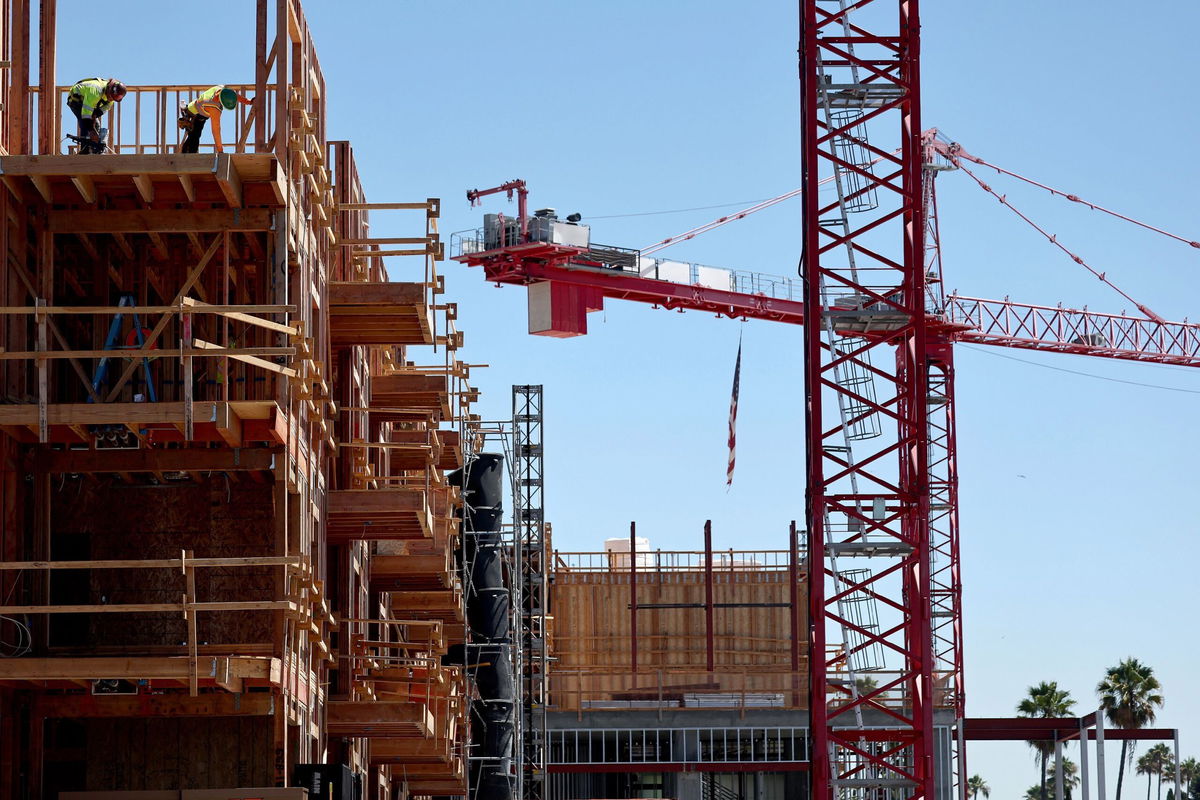Wholesale inflation slowed again last month

Construction continues on a mixed-use apartment complex in Los Angeles in August.
(CNN) — Another day, another encouraging inflation report — but one with enough hint of concern to keep the victory parades at bay and keep the Federal Reserve from going big on its impending rate cut.
The Producer Price Index, which measures average price changes seen by producers and manufacturers, markedly slowed in August to a rate of 1.7% from an annual increase of 2.1% the month before, according to Bureau of Labor Statistics data released Thursday.
On a monthly basis, prices rose 0.2%, a faster pace than in July, when prices were flat. August’s monthly increase was driven by a 0.4% gain on the services side, as goods prices were unchanged, thanks in part to falling energy prices.
While producer prices overall cooled for a second straight month, a closely watched measure of underlying inflation showed that some price hikes are remaining stubbornly elevated.
A similar theme played out Wednesday when the August Consumer Price Index fell to its lowest headline rate in three-and-a-half years but the core (excluding gas and food) reading accelerated more than anticipated.
“It’s a déjà vu,” Andreas Hauskrecht, clinical professor of business economics at Indiana University’s Kelley School of Business, told CNN in an interview. “It’s overwhelmingly positive, but the service side is a concern.”
Excluding the more volatile categories of food and energy, core PPI advanced 0.3% from July, countering a 0.2% decline seen the month before. That pushed the annual rate to 2.4%, from 2.3%, according to the report.
Economists had expected that the headline PPI would increase 0.2% on a monthly basis and 1.8% annually, and core would rise 0.2% for the month and 2.4% annually, according to FactSet estimates.
Stubborn services but relief on the way?
PPI serves as a potential bellwether for retail-level inflation in the months ahead. On Wednesday, the Consumer Price Index cooled to its lowest rate since February 2021 but also showed that some inflation pressures — specifically, housing-related costs — remain stubbornly elevated.
“We hope it’s seasonal; we hope that there are time lags” that could mean services inflation will ease in the future, Hauskrecht said.
The August PPI’s services increase was pushed higher by a 0.6% gain in trade services, a measurement of gross margins of wholesalers and retailers. Trade services is a volatile category: It leapt 1.3% higher in June, clouding the more positive data that month, and then corrected in July by dropping 1.7%.
However, in August, trade services bumped higher by 0.6%, landing smack dab between the gains seen in April and May and indicating an annualized three-month rate of 3.9%.
The margins measured by the PPI don’t translate entirely to profit, as some will flow to costs, but with it running above overall inflation there is some indication that there’s a runway for consumers to see more price relief in the near future.
“This implies that consumers have not benefitted fully from the recent moderation in input cost inflation,” Ian Shepherdson, chief economist at Pantheon Macroeconomics, wrote in a note to clients Thursday.
“Nonetheless, we continue to think that a combination of declining inflation expectations, slowing growth in consumer demand and slightly elevated levels of inventory will compel retailers to compete more keenly on price.”
He noted how auto sector margins have fallen steadily for two years, and the expectation is for other retailers to face similar pressures.
On deck: The Fed’s expected rate cut
This is the last inflation report the Federal Reserve will have in hand before officials hold their monetary policy meeting next week, where they are expected to announce a quarter-point rate cut after hiking rates to a 23-year high in a prolonged battle to bring down elevated prices.
“With PPI basically repeating yesterday’s CPI reading and jobless claims in line with expectations, the decks have been cleared for the Fed to kick off a rate-cutting cycle,” said Chris Larkin, managing director of trading and investing at E*Trade. “The markets are anticipating an initial [quarter-point cut], but the discussion will soon turn to how far and fast the Fed is likely to trim rates over time.”
As for next Wednesday, markets have an 85% probability for a quarter-point cut, according to the CME Group’s FedWatch Tool. Those odds have vaulted significantly higher from this time last week, when it was 60% — but that was before the August jobs report showed the labor market was cracked but not crumbling and CPI showed services inflation remains a trouble spot.
“The signal from the labor market is it’s time to decrease rates, it’s time to stimulate [the economy],” Hauskrecht said. “The labor market data alone could rather indicate that the Fed is behind the curve, and that the Fed should decrease by [a half point]. But combine that with the CPI data, the headline and core … is it necessary to raise interest rates? Yes. Will the Fed signal a [half-point] cut? No, it will not.”
The-CNN-Wire
™ & © 2024 Cable News Network, Inc., a Warner Bros. Discovery Company. All rights reserved.